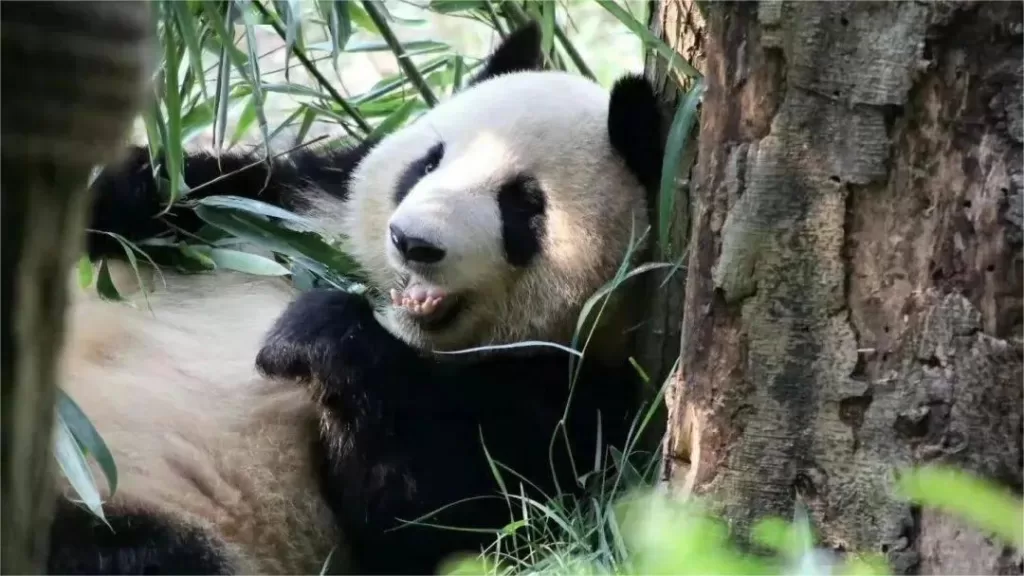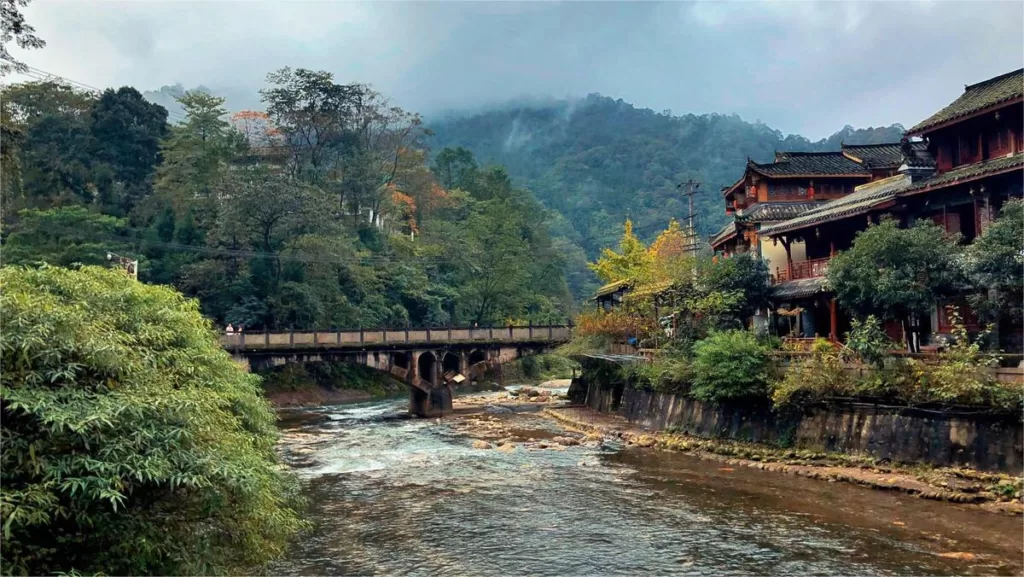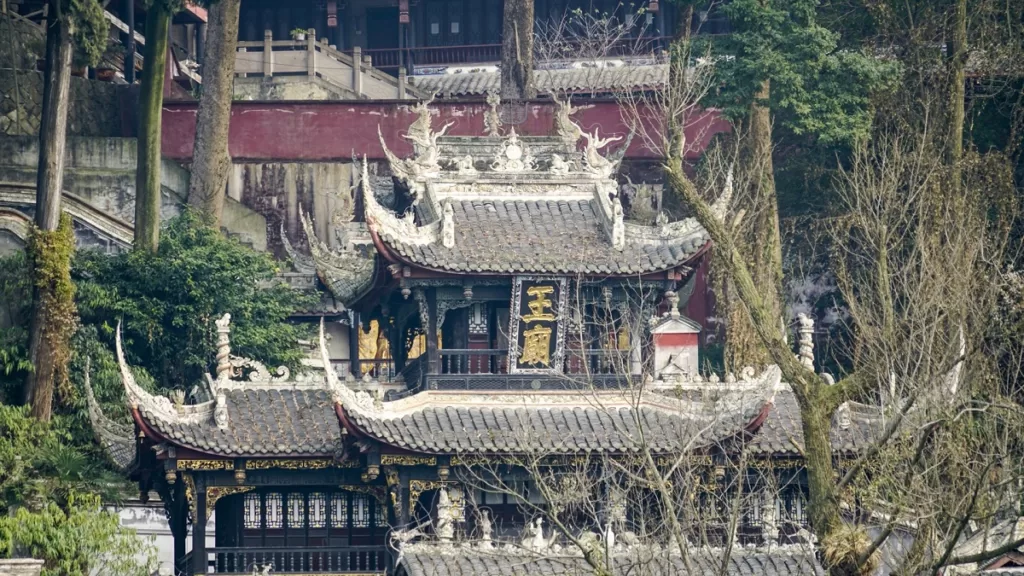Mount Qingcheng (青城山), located in the Sichuan Province of China, is a place of profound natural beauty and cultural significance. As one of the most renowned Taoist mountains in the country, it holds a special place in the hearts of both locals and visitors alike.
Rising majestically to a height of approximately 1,260 meters, Mount Qingcheng is characterized by its lush greenery, serene forests, and winding paths. The mountain is divided into two main parts: the Front Mountain and the Back Mountain. The Front Mountain is known for its exquisite temples, pavilions, and beautiful scenery, while the Back Mountain offers a more rugged and adventurous experience with its hiking trails and picturesque valleys.
The mountain is closely associated with Taoism, a spiritual tradition that emphasizes harmony with nature and the pursuit of inner peace. It is believed that the legendary Taoist philosopher, Zhang Daoling, established the first Taoist temple on Mount Qingcheng around 2,000 years ago. The mountain subsequently became an important center for Taoist teachings, attracting scholars and practitioners throughout history.
In addition to its spiritual significance, Mount Qingcheng is a popular destination for outdoor enthusiasts. Its diverse landscape offers opportunities for hiking, climbing, and exploring hidden waterfalls. The mountain is also known for its tranquil hot springs, which are believed to possess therapeutic properties.
Visiting Mount Qingcheng allows one to immerse themselves in the beauty of nature while experiencing the rich cultural heritage of Taoism. The serenity and tranquility found in this mountainous haven make it an ideal retreat from the hustle and bustle of everyday life, leaving visitors refreshed and inspired by its timeless allure.
Table of Contents
- Basic Information
- Location and Transportation
- Highlights of Mount Qingcheng
- Map and Easy Route
- Vlog about Mount Qingcheng
- History of Mount Qingcheng
- Useful Tips from Genuine Reviews
- Attractions near Mount Qingcheng
Basic Information
| Estimated Length of Tour | Over 3 hours |
| Admission Ticket | Front Mountain: 90 RMB Back Mountain: 40 RMB |
| Tourist Attractions | Yuecheng Lake cruise in front mountain: 5 RMB Cuiying Lake cruise in back mountain: 2 RMB |
| Cablecar Price | Front Mountain: Singe way: 30 RMB Round: 50 RMB Back Mountain: Singe way: 30 RMB Round: 55 RMB |
| Opening Hours | 8.00 – 18.00 (2nd March – 30th November) 8.00 – 17.00 (1st December – 1st March) |
| Telephone Number | 0086-028-87111907 |
Location and Transportation
Mount Qingcheng is located in the southwestern part of China, specifically in the Dujiangyan City of the Sichuan Province. It is situated approximately 68 kilometers away from the provincial capital, Chengdu.
The most convenient way to get to Mount Qingcheng from Chengdu is by Train. You can transfer to an express railway at Xipu Station (犀浦站) on metro line 2 or 6, which will take you directly to the foot of the mountain. The train departs about every half an hour from 6.00 to 21.40.
| Train No. | Departure | Arrival | Travel Time | Price |
| C6101 | 06:00 | 06:23 | 23 minutes | 10 RMB |
| C6105 | 07:36 | 08:11 | 35 minutes | 10 RMB |
| C6109 | 08:23 | 08:46 | 23 minutes | 10 RMB |
| C6111 | 09:21 | 09:50 | 29 minutes | 10 RMB |
| C6113 | 09:49 | 10:27 | 38 minutes | 10 RMB |
| C6115 | 10:10 | 10:42 | 32 minutes | 10 RMB |
| C6117 | 11:05 | 11:34 | 29 minutes | 10 RMB |
| C6119 | 11:15 | 11:43 | 28 minutes | 10 RMB |
| C6121 | 11:27 | 11:56 | 29 minutes | 10 RMB |
| C6123 | 11:37 | 12:07 | 30 minutes | 10 RMB |
| C6125 | 11:55 | 12:27 | 32 minutes | 10 RMB |
| C6127 | 12:56 | 13:31 | 35 minutes | 10 RMB |
| C6129 | 13:13 | 13:36 | 23 minutes | 10 RMB |
| C6131 | 13:21 | 13:57 | 36 minutes | 10 RMB |
| C6133 | 13:30 | 14:08 | 38 minutes | 10 RMB |
| C6135 | 13:40 | 14:17 | 37 minutes | 10 RMB |
| C6137 | 14:50 | 15:19 | 29 minutes | 10 RMB |
| C6139 | 15:00 | 15:35 | 36 minutes | 10 RMB |
| C6141 | 15:23 | 15:58 | 35 minutes | 10 RMB |
| C6143 | 15:43 | 16:18 | 35 minutes | 10 RMB |
| C6145 | 16:24 | 16:53 | 29 minutes | 10 RMB |
| C6147 | 16:33 | 17:13 | 40 minutes | 10 RMB |
| C6149 | 16:49 | 17:19 | 30 minutes | 10 RMB |
| C6151 | 17:12 | 17:47 | 35 minutes | 10 RMB |
| C6153 | 17:34 | 18:03 | 29 minutes | 10 RMB |
| C6159 | 19:33 | 20:02 | 29 minutes | 10 RMB |
| C6161 | 19:55 | 20:29 | 34 minutes | 10 RMB |
| C6163 | 20:32 | 21:06 | 34 minutes | 10 RMB |
| C6165 | 21:40 | 22:09 | 29 minutes | 10 RMB |
Highlights of Mount Qingcheng
Taoist Heritage

Mount Qingcheng holds significant Taoist heritage, making it a revered destination for spiritual seekers. It is believed that the mountain served as a birthplace of Taoism and holds connections to the legendary Taoist philosopher, Zhang Daoling. The mountain is adorned with numerous Taoist temples, such as the Jianfu Palace, Shangqing Palace, and Tianshi Cave, where visitors can explore intricate carvings, serene courtyards, and experience Taoist rituals. The Taoist heritage of Mount Qingcheng offers a profound insight into the ancient teachings, philosophies, and practices of Taoism, attracting pilgrims and enthusiasts from around the world.
Front Mountain Scenery

The Front Mountain Scenery of Mount Qingcheng captivates visitors with its breathtaking beauty and cultural landmarks. Walking along the scenic paths, one is greeted by lush forests, serene courtyards, and stunning vistas. The Jianfu Palace, a prominent Taoist temple, stands as a testament to the mountain’s spiritual significance. Intricate carvings, graceful architecture, and tranquil gardens create a harmonious atmosphere. Other highlights include the Shangqing Palace and Tianshi Cave, which offer captivating views and insights into Taoist traditions.
Back Mountain Hiking

For adventurous souls, the Back Mountain of Mount Qingcheng offers exhilarating hiking opportunities amidst its rugged and captivating landscapes. The hiking trails wind through dense forests, hidden valleys, and babbling streams, providing a sense of serenity and connection with nature. As you ascend, you’ll be rewarded with panoramic views of the surrounding mountains and lush greenery. The journey may lead you to the tranquil Cuiying Lake, where you can immerse yourself in the refreshing ambiance. Back Mountain Hiking in Mount Qingcheng is a thrilling experience that allows you to explore the untamed beauty of the mountain while challenging your physical and mental prowess.
Hot Springs

Nestled amidst the tranquil surroundings of Mount Qingcheng, the natural hot springs provide a soothing and rejuvenating experience for visitors. Known for their therapeutic properties, the hot springs offer a respite from the stresses of everyday life. Surrounded by lush greenery and breathtaking landscapes, immersing oneself in the warm, mineral-rich waters is a perfect way to relax and unwind. The hot springs of Mount Qingcheng provide a blissful retreat, allowing visitors to indulge in a serene and healing experience while basking in the natural beauty of the mountain.
Cultural Festivals

Throughout the year, Mount Qingcheng hosts vibrant cultural festivals that showcase the rich traditions and heritage of the region. These festivals provide a unique opportunity for visitors to immerse themselves in the local culture and experience lively celebrations. From Taoist rituals to traditional performances, the festivals offer a captivating glimpse into the customs and practices of the area. Whether it’s witnessing colorful processions, participating in Taoist ceremonies, or enjoying traditional music and dance, the cultural festivals of Mount Qingcheng create a vibrant and joyful atmosphere, leaving visitors with lasting memories of the cultural diversity and spirit of the mountain.
Map and Easy Route
For a more relaxed visit to Mount Qingcheng, follow this easy route:

- Arrival and Transportation:
- Taxi: Take a taxi directly to the main entrance of Mount Qingcheng.
- Shuttle Bus: At the base, board a shuttle bus (10 CNY per person) which takes you to the entrance of the scenic area. Walking from the base to the entrance takes about 40 minutes.
- Exploring the Scenic Area:
- Once inside the main entrance, take the route to the right. Walk for about 30 minutes to reach Yuecheng Lake.
- Boat Ride: Purchase a boat ticket (5 CNY per person) to cross the lake. The boat ride takes just 2-3 minutes, but you can also walk across if preferred, which takes about 10 minutes.
- Cable Car:
- From the lake, walk to the cable car station. The round-trip fare is 60 CNY per person. The cable car ride takes about 10 minutes to reach Ciyun Pavilion.
- Sightseeing:
- From Ciyun Pavilion, enjoy a 60-minute walk past Shangqing Palace and Donghua Hall, heading straight to Laojun Pavilion.
- Laojun Pavilion: Offers a panoramic view of Mount Qingcheng and the surrounding city.
- Choosing Your Route:
- There are two paths from Shangqing Palace to Laojun Pavilion. One path is steep with around 300 steps but provides beautiful scenery. The other is a flatter path starting from the left side of the Daoist temple.
- Resting Options:
- Throughout the route, there are “sliding poles” for resting. If you feel tired, you can use these, which is especially helpful for the elderly and children.
- Returning:
- Simply retrace your steps to return to the base.
Vlog about Mount Qingcheng
History of Mount Qingcheng
Mount Qingcheng, a revered Taoist sanctuary, boasts a rich history intertwined with legend and spirituality. Its significance dates back to ancient China, and its story is a testament to the deep cultural and religious heritage of the region.
Legendary Beginnings
The origins of Mount Qingcheng are steeped in legend. During the reign of Emperor Huangdi (the Yellow Emperor), it is said that a Taoist sage named Ning Fengzi resided on the mountain, practicing his craft and teaching the art of controlling wind and clouds, known as “Longji Zhi Shu” (the Technique of Dragon Ascension). This legendary figure’s influence was so profound that Emperor Huangdi built an altar and honored him as one of the Five Great Mountain Deities. As a result, Mount Qingcheng was also referred to as “Zhangren Mountain,” with a temple built in his honor known as Zhangren Temple. In ancient times, it was grouped with other prominent Taoist mountains—Mount Wudang in Hubei, Mount Longhu in Jiangxi, Mount Qiyun in Anhui, and Mount Jingfu in Shaanxi—forming a prestigious ensemble of Taoist sacred sites. These mountains were dedicated to various Taoist deities, including Zhenwu the Demon-Subduing Great Emperor, Ning Fengzi the Five Great Mountain Deity, the Jade Emperor, and other revered figures.
Early Taoist Influence
The historical importance of Mount Qingcheng began to solidify during the late Han Dynasty. Yin Changsheng, one of the “Eight Immortals of Shu,” is said to have practiced Taoism on the mountain. However, it was Zhang Daoling who truly established Mount Qingcheng as a major Taoist center. At the beginning of the Eastern Han Dynasty, Zhang Daoling arrived at Heming Mountain (now located in Dayi County, Chengdu) and founded the Way of the Five Pecks of Rice (also known as the Tianshi Dao or Way of the Celestial Masters). As the ancient Heming Mountain and Mount Qingcheng are part of the same Minshan mountain range, Zhang Daoling initially began his teachings on Heming Mountain before moving to Mount Qingcheng to further propagate his doctrine and eventually achieving immortality there.
In the second year of the Han An Emperor’s reign (143 AD), Zhang Daoling settled on Mount Qingcheng after completing the writing of the “Twenty-Four Taoist Books.” Here, he founded Taoism as a native Chinese religion, elevating Mount Qingcheng to become one of the four most important Taoist mountains in China.
Taoism in the Tang and Song Dynasties
During the Tang and Song Dynasties, Mount Qingcheng saw the flourishing of martial arts, which, combined with Taoist alchemy, natural healing, I Ching, and medicine, formed a unique and complete system. It became one of the four major sects of Chinese martial arts. The support of Taoism by the Sui and Tang rulers led to Mount Qingcheng becoming a prominent “Immortal’s Capital” during this period, with Taoist temples and prominent figures appearing throughout the mountain.
After the Tianbao Rebellion, when central China was in turmoil, Emperor Xuanzong and Emperor Xizong of the Tang Dynasty took refuge in Shu (Sichuan). Emperor Xizong ordered the construction of a Lingbao Taoist altar on Mount Qingcheng, setting up 2,400 altars for rituals.
During the late Tang and Five Dynasties period, several famous Taoist figures, such as Peng Xiao and Chen Tuan, visited Mount Qingcheng. Notable Taoist Du Guangting also spent his final years on Mount Qingcheng, where he compiled and wrote numerous Taoist texts. Later generations built the “Du Guangting Reading Pavilion” by Baiyun Creek in his honor.
In the late Tang period, Du Guangting’s arrival on Mount Qingcheng marked the fusion of the Tianshi Dao tradition with the Shangqing Dao. Shangqing Dao promised ascension to the “Shangqing Heaven,” a higher realm than the “Taixing Realm” of the traditional Tianshi Dao.
During the Northern Song Dynasty, the 30th generation Celestial Master Zhang Jixian visited Mount Qingcheng to pay homage and revived the Celestial Master’s teachings at Changdao Temple.
The Ming and Qing Dynasties
In the Ming Dynasty, Taoism on Mount Qingcheng belonged to the Quanzhen School’s Longmen Sect. During the late Ming Dynasty, continuous warfare led to the dispersion of Taoist practitioners.
In the eighth year of the Kangxi Emperor’s reign (1669), Chen Qingjue of the Longmen Sect from Mount Wudang came to Mount Qingcheng to oversee the Taoist practices, restoring order to the situation. Today, Taoism on Mount Qingcheng is associated with the Quanzhen School’s Longmen Sect, specifically the Dantai Bixiao Sect.
Modern Recognition
In 1982, Mount Qingcheng, as a crucial part of the Sichuan Mount Qingcheng and Dujiangyan Scenic Area, was approved by the State Council as one of the first batch of national scenic spots. In 2000, Mount Qingcheng, together with Dujiangyan, was listed as a World Cultural Heritage site, recognizing its outstanding cultural and historical value.
Useful Tips from Genuine Reviews
Avoid Walking Down the Mountain Path: It’s advised not to take the mountain path down as about one-third of the journey is covered in old stone paths that have become uneven and difficult to traverse. Especially when descending, the narrow and challenging conditions make it less preferable.
Get a Reliable Map: The official notice board maps in the area might be unclear due to constant poking, making it difficult to identify the next location. It’s recommended to either find a reliable map of Qingcheng Mountain in advance or spend a small fee to purchase one (around 5 yuan).
Explore the Front Mountain Strategically: When exploring the front mountain, it’s suggested to go up following the left route and get down following the right route. The scenic views on the front mountain are mostly on the left side along the route, while the right side has fewer notable attractions.
Utilize the Shuttle Bus: For transportation to and from the mountain gate and the high-speed rail station, it’s strongly recommended to use the shuttle bus. Walking back and forth might take around one and a half hours. The shuttle bus is available just across the road from the high-speed rail station, and the official round trip fare is 35 yuan. Other forms of transportation are not recommended as regular vehicles are not allowed inside.







During my few days in Dujiangyan, I found that taking a taxi never cost more than 20 yuan. The scenic bus to Qingcheng Mountain, which is only 1.8 kilometers, charges 10 yuan per person, so for two people that’s 20 yuan. Plus, it costs another 10 yuan to travel from the bus pick-up point to the visitor center, which is just 670 meters away. It’s pretty frustrating.
My hiking route was from Taian Ancient Town (泰安古镇) to Wulonggou (五龙沟), then to Youyicun (又一村), Yincui Lake (隐翠湖), and back to Taian Ancient Town. The entire loop took about three hours to complete on foot. The classic scenery is mainly concentrated between Wulonggou and Youyicun, where the small waterfalls along the plank road and the bamboo rafts are particularly beautiful. The other areas are fairly similar to one another in the mountains. I set out at noon, and there… Read more »